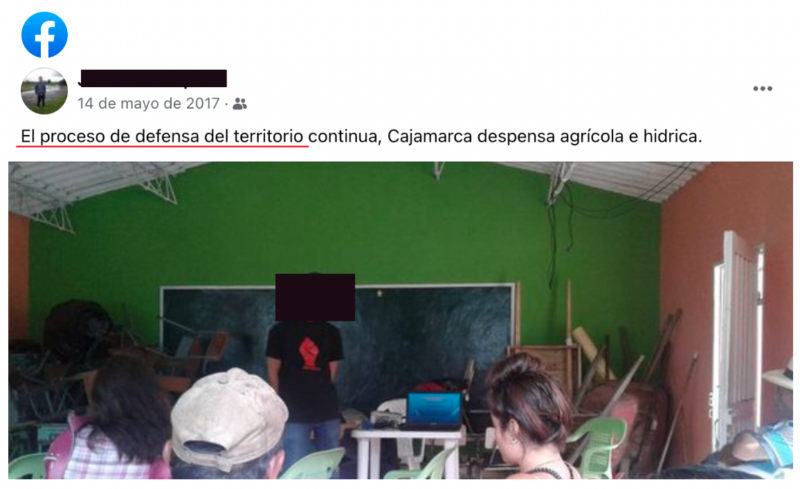What can the battle around a new mine in Colombia tell us about the past and future of environmentalist organizing in Latin America? Matrix Postdoc Julia Sizek interviewed Ángela Castillo, who is a recent PhD graduate from UC Berkeley’s Anthropology Department, Assistant Professor of Anthropology at Pitzer College in Southern California, and a member of the editorial team of Engagement, the blog of the Anthropology and Environment Society. Castillo studies environmental politics and struggles over natural resource extraction with an emphasis on Latin America, particularly Colombia. Her scholarly work explores how environmental and territorial disputes give rise to new forms of political action.
What is the Colosa gold project, and why is it controversial?
I think of the Colosa project not as a specific mining site or a corporation, but as a concentrated effort to industrially exploit one of Colombia’s largest subterranean gold deposits through an open-pit mine. From this perspective, the Colosa project is a set of operations, actors, relations, and capital arranged to extract Andean highland underground gold and transform it into a mineral resource that is sold and bought in the market. While the open-pit site has not been built as of 2024, some of the operations fundamental to bringing the Colosa project to life have included a geological exploration of Colombia’s Andean ranges, which was funded by the corporation between 2003 and 2007. This expedition put more than 100 geologists and fieldworkers to work exploring Colombia’s underground and identifying mineral deposits. After that, the corporation secured mining titles over approximately 22,000 acres in the region and started exploration activities, such as drilling and sampling, in the municipality where the deposit was located (Cajamarca, Tolima). All of these components constitute the Colosa project.
The Colosa project is unique: it was going to be one of the first montane industrialized mining sites in Colombia. Until the end of the 20th century, industrial mining had been limited to lowland areas and semi-flat areas.
La Colosa is controversial for several reasons. First, elevated areas in tropical regions harbor unique ecosystems, such as Andean tropical forests (cloud forests), páramos (high tropical ecosystems above the treeline), and tropical glaciers, and the project could impact these ecosystems. These ecosystems are biodiversity hotspots, and many rivers originate there.
Second, the project is controversial because these mountains are home to communities of small farmers, or campesinos, practicing semi-intensive agriculture with cash crops. An open-pit mine is one in which layers of the mountain are blasted and removed. Eliminating the tree coverage and different layers of soil would thus make agriculture impossible and endanger endemic animals and plants. The project was very poorly received by small farmers, people living in nearby towns, in the regional capital, and in other parts of the country. The Colosa was controversial because it was associated with the destruction of water, biodiversity, and food.
A third reason the project is controversial is the relationship between this mountain range (not specifically the zone of the Colosa, but the broader area) and the history of Colombia’s political violence and internal conflict. The mountain range has been home to both armed and non-armed revolutionary and reformist movements (some of which turned into guerrillas, while others did not). What I want to flag is that these are spaces where state territorialization has always been contested and, therefore, conspicuously incomplete. Of course, the interest in transforming the high Andes into a new mining landscape would bring all these elements into a complicated interaction.
In your research, you followed an anti-mining coalition and groups like the Environmental Committee for the Defense of Life. How did the group conceptualize their project as one of defending life?
I followed a coalition formed by different organizations, including groups like the Environmental Committee for the Defense of Life. I also track other groups in nearby towns. This coalition isn’t formal; it lacks a name and people don’t refer to it as “our coalition,” but they come together to act, which is what I consider the coalition. The Environmental Committee for the Defense of Life played a pivotal role in shaping the terms and material conditions for this type of political action. Using concepts from Black scholars like Berenice Johnson (1983)1, I describe the work that these organizations do as “coalitional,” meaning that relations and interactions are maintained and flourish despite differences, mistrust, potential harm, and disagreements among people.
Since starting my fieldwork, I have been interested in unpacking and ethnographically elaborating the concepts this coalition uses to frame their political work. They refer to their actions as “territorial, water, and life defense.” What underpins and signals these terms? Why opt for these rather than “environmental activists”? Why have these notions gained so much traction globally?
The concept of life is particularly fascinating; my research indicates that it derives from a situated reflection of Colombia’s political history and a reflection of what is human and more-than-human life.2 However, it is also a term that invites potential links and comparisons with other movements that foreground life and vitality, such as Black Lives Matter in the US or Ni Una Más in Latin America.
To understand what they mean by life, I want to mention that during fieldwork, I constantly hear from Committee members the expression, “against a politics based on death, we put forward a politics of life” (contra una política de muerte, nosotros avanzamos una política de la vida). What is being articulated here is a concrete theorization of how Colombian politics (both state and counter-state) have been defined by the use of violent means to either exterminate the politically different “other” (see the Patriotic Union Political Party state-sponsored genocide, Inter-American Court of Human Rights, Decision July 27th, 2022), or to force a recalibration of political forces to promote resource redistribution or political rights, as well as to end exploitation, domination, or exclusion. When defenders invoke “life,” I identify an ongoing reflection on the role of violence in politics. However, it is not necessarily a Global North liberal perspective on violence.
Another thread in their use of the concept of life relates to a situated discussion of what constitutes human life and what defines a dignified human life. Another expression that I often hear in Tolima and other parts of Colombia is “until dignity becomes customary” or “until we are completely accustomed to dignity” (hasta que la dignidad se haga costumbre). Here, they theorize that human life is considered worthy and that it commands respect. They argue that forms of human life cannot be replaced or radically transformed merely for the purpose of converting areas into extractive sites.
A final thread in their use of the concept is how they consider the relationship between human life and more-than-human life. “In defense of life” does not necessarily center human life as unique, but acknowledges that human life occurs alongside and depends on other forms of life. It is also very interesting how, for example, these defenders seldom mention the planet, the globe, or humankind. Those are notions that are not underpinning their political action, although they are up-to-date in understanding global warming and the climate crisis. However, I think the concept of life, in some ways, levels the status between who defends and who is defended, which is not necessarily present in articulations where environmentalists protect the planet.
This leads us to one of the central concepts that the movement uses to think about itself: as a proceso. What is the proceso, and how does the concept of the proceso shape their advocacy?

In the image above, we see an example of the use of the notion of “proceso,” which translates as “the process.” In the image, we see a picture of an organizing event with Cajamarca’s farmers, indicating that this action is one way in which the “proceso” remains alive. A simple way to define “proceso” is that it is the local term for both the coalition they created, and also the term they use to theorize about a social movement. I never heard them talking about “our coalition” or “our social movement,” although technically, this is an example of what some literature would call new social movements oriented to environmental issues. I am still thinking through the relevance of “proceso,” and by that, I mean the theoretical, political, and affective affordances and foreclosures the term allows for defenders, allies, and outsiders. The term underscores something that is made of moving pieces, that unfolds in time, and that is goal-oriented. It is not a term that refers to formal and bounded organization, so I have the idea that when they use “proceso,” they are emphasizing three different aspects: coalitional practices to refuse the project, mutability, and post-extractive futures.
I think that “proceso” shapes their advocacy by allowing them to somewhat detach and separate from more formal organizations, and instead focus on the broad political goal. If we want to reference scholars who have thought about time, like Reinhart Koselleck (2004), we can say that “proceso” speaks to situated spaces of experience and horizons of expectation that define this coalition and its activities.
How did the proceso begin?
The proceso began in 2007 when the Colosa project was publicly announced. People recalled that they had seen white SUVs, machines, and workers going around Cajamarca (the town where the gold deposit is located). However, since Cajamarca is also crossed by one of Colombia’s most important highways, many local dwellers thought those machines were related to a road tunnel that several Colombian governments have been promising for decades. However, in 2007, former president Alvaro Uribe announced the Colosa as one of the most important mining projects in Colombia’s history and as an engine of economic development. Small farmers in Cajamarca realized that a mine was going to be built in the mountain. That was a huge shock for many of them.
In my research, I show that the initial shock was important to ignite the proceso, but there were two historical conditions that came together to bring the proceso to life. The first one is that these campesinos had been participating in different projects aimed at rethinking farming in the mountain. Although agriculture was done by smallholders, it was an intensive form of agriculture that, since the late 1980s, had been using more plots of land, water, fertilizers, and pesticides. On one hand, farmers were aware of their reliance on fertilizers and pesticides. They complained about the prices and also about the difficulties of sustaining permanent cash crops. On the other hand, environmental conservation NGOs were concerned about how these practices could impact biodiversity, the forests, and the páramos (mountain ecosystem above the treeline). In the early 1990s, NGOs arrived with different projects and initiatives, including private reserves and agro-ecological projects. Agro-ecology emphasized organic fertilizers and pesticides, better use of the soils, crop combinations, and different waste management, among other things. When the Colosa project arrived, campesinos and local NGOs had been working together for more than 20 years in a theoretical and practical critique of economic development through intensive agriculture and agricultural experiments. Small farmers in these projects were the first to protest against the Colosa and looked for allies.
The second historical condition was the presence of a group of students, professors, and researchers in the schools of biology, agronomy, and social sciences in Ibagué, the regional capital. They had been trained under professors who applied the principles of collaboration, Research-Active Participation (Investigación-Acción Participativa, a form of research created by a Colombian sociologist during the 1960s), and liberation theology. All of these emphasized a form of research based upon collaborating with communities. It implied both concrete projects and a personal disposition on how to be a scholar. When small farmers started to contact students and faculty, many of those trained in these principles openly listened to small farmers and started attending meetings and organizing events. This was the beginning of the “proceso.”
In sum, on one level, it was the articulation of small farmers and working-class members of the public regional university. On another level, it was the articulation of two traditions defined by critiques of intensive agricultural production and of apolitical scholarly research.
How does the concept of the proceso fit into the broader history of popular environmentalism, or ambientalismo popular, in Colombia?
Throughout the 20th century, Colombian public universities have been a space for scholarly traditions that embraced collaboration and shared political goals with different sectors of society.
In particular, Colombian public universities were the settings where the concept of popular classes (clases populares) emerged in the 1960s.This was an alternative theorization done by political leaders who were also researchers, professors, liberation theology activists, and even revolutionaries. They challenged theterm “working class” because, for them, it did not fully encompass sectors such as the unemployed and small farmers. They started to use popular classes and call for united fronts (frentes unidos), a sort of space that brings together different social sectors. One can see them as proto-coalitional spaces.
Many students were trained in this tradition. Relevant to the Colosa case is Professor Gonzalo Palomino, an agronomist who was deeply interested in environmental issues. When he arrived at Tolima’s public university to be a professor in the late 1970s after being trained in collaborative action research, he applied all these principles and adapted them to do research and advocacy about agriculture and environmental matters.
In doing so, he nourished a specific type of environmental advocacy and action in Colombia. Over three decades, he organized a group of students and faculty to explore environmental problems and their impacts on the popular classes, using the conceptualization coined by his mentors during the 1960s. The fieldwork and writing that resulted from these activities gave form to one of the first examples of popular environmentalism in Colombia.
Popular environmentalism took place outside of the urban and political centers, like Bogota. It was an environmentalism not performed by white Colombians doing conservation, but a kind of environmentalism practiced by low-income researchers and communities, in which ecological phenomena were thought about and explored in relation to the humans living there. The relationship of this tradition of popular environmentalism to the proceso against the Colosa is direct. Many of the students and faculty who established alliances with small farmers and who then formed organizations, such as the Committee, were directly trained by Professor Palomino in the principles of popular environmentalism. Without their involvement in this tradition, I think it would be hard for them to sustain the coalition.
This part of the research is relevant because it reveals how different sedimented histories underpin the resistance against the Colosa project. Examining the connections among these various traditions broadens our understanding of the anti-mining politics that have emerged in central Colombia. This approach moves beyond the narrow focus of some studies that highlight only a few legal actions taken by defenders against the mining company as the sole significant events in this dispute. (2024). Of course, the popular consultations or local referendums— binding legal tools that were used to ask citizens of Cajamarca and Piedras about their opinion on industrialized mining, and through which voters rejected industrialized mining — were legally consequential events. But the forms of life and political action that these defenders configured over two decades cannot be reduced to these events. My research excavates these different critical traditions cultivated amidst violence and how their articulation is fundamental for the type of coalitional action that emerged in the context of the Colosa.
How might the lessons from the proceso change how we think about social movements and coalition-building?
That is what I am trying to think about more. Established theorizations of social movements by both scholars in the North and the Global South draw on fixed notions of what social movements are and how their actions are strictly shaped by windows of opportunity that depend on the state.
As a researcher, I am halfway situated between the Global South and the Global North, so to avoid flattening this phenomenon by the term “social movement,” I decided to give proceso a conceptual chance. I wanted to see if the word can do the same for a reader that it does for defenders in their different organizing events.
When I was in the field, proceso was invoked in various settings and occasions. For instance, I heard statements like, “it is great that you want to join and help the proceso,” or “what we have to keep in mind is taking care of the proceso,” or “I’ve learned many things by being part of the proceso.” I think that the term “proceso” helps them make sense of that kind of political and care work to maintain connections between groups and even more-than-human entities, which are not fully captured by the word “social movement.” I don’t think right now that “proceso” could serve to theorize other social movements, but it could help shed light on how to theorize social movements by taking seriously the terms these coalitions use to make sense of their political labor.
What is the status of the Colosa project today, and how has the opposition to the project continued over time?
As of April 2024,, the corporation has not been able to advance the project. There are no consistent exploration activities, drilling, platforms, or sampling. The corporation still holds some mining titles, so there are billboards in the area, sometimes protected by security guards. The physical signs are marking their contested territorial claims. But there is no project currently.
However, I don’t want to suggest that the dispute ended and the mining corporation abandoned their endeavours to exploit the area; this would be naïve. Since the last popular consultation took place in 2017, the corporation has initiated dozens of legal actions to undermine the results. They have lobbied to change the members of Colombia’s Supreme Court. In 2018, a new Constitutional Court ruled against using popular consultations to intervene in the authorization of mining projects. This questioned the legitimacy of the consultation processes in Piedras (2013) and Cajamarca (2017) that stopped the Colosa project. However, the decision was not enough to legally overturn the results in Cajamarca. A very particular and contentious legal situation is currently unfolding.
Amidst that situation, the work of defending territory, water, and life has evolved into different practices: actualizing post-extractive futures via projects that ensure small farmers can produce crops in alternative ways, and defending the popular consultation results. Defending or taking care of the popular consultations’ results entails establishing alliances with lawyers to intercept or respond to the corporation’s legal actions, advocating for new legislation (such as the Environmental Democracy Law), and connecting with other procesos against the same corporation elsewhere in Colombia.
Footnotes
1. “Coalitional Politics: Turning the Century” by Black scholar, activist, and artist Berenice Johnson was published in 1983 in a volume titled Home Girls. A Black Feminist Anthology, edited by Barbara Smith. It was based on a public presentation that Johnson gave in 1981 at the West Coast Women’s Music Festival in Yosemite National Park, California.
2. Within the field of multispecies ethnography, the concept of “more-than-human” life refers to all elements of the environment that are not human but play a fundamental role in ecological and social interactions. More-than-human entities can include plants, animals, fungi, bacteria, elements, and more. Multispecies approaches in anthropology and ethnography examine and highlight the interconnected relationships between humans and other life forms.



